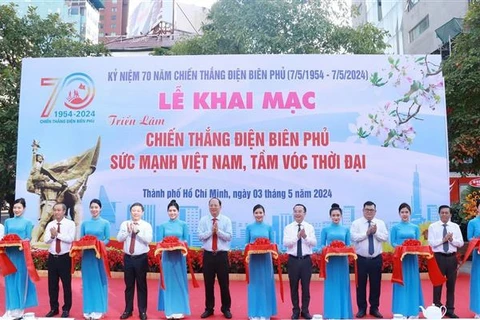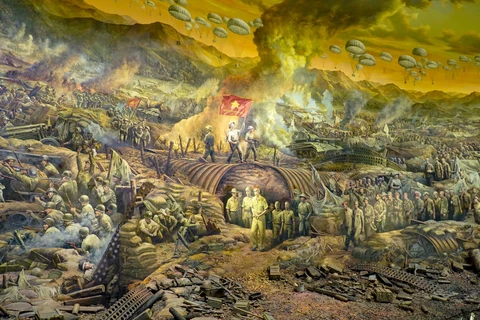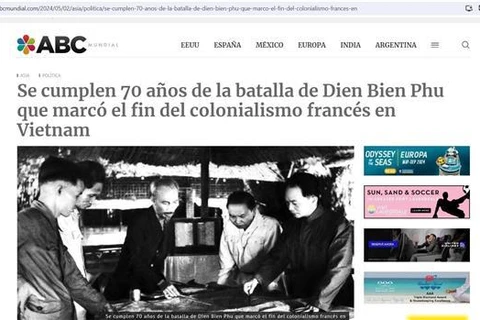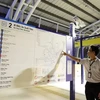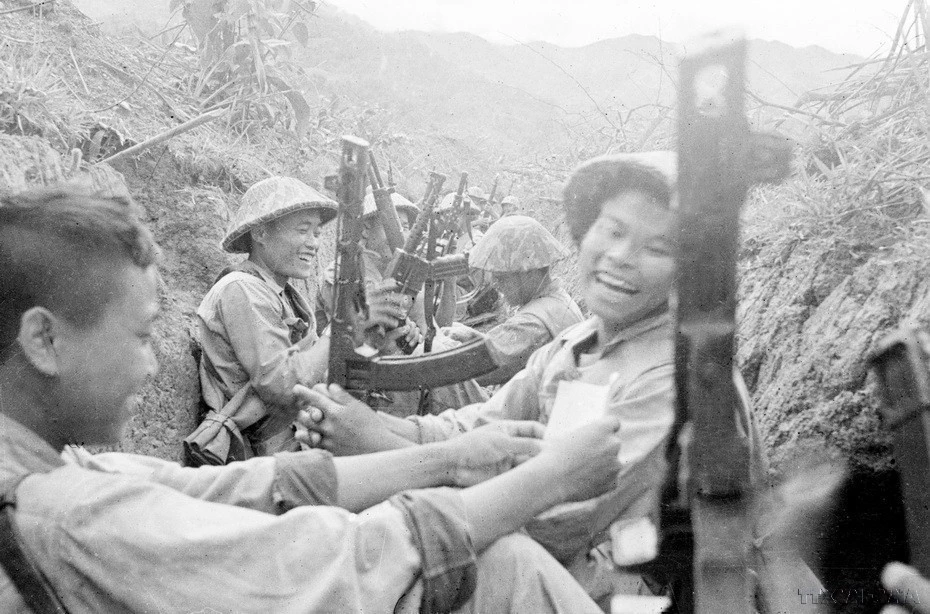
Hanoi (VNA) - “I dreamed of peace while in the battle and when it came true, my dreams are all about my comrades every night,” Dien Bien Phu veteran Luong Van Huong, now 96, told the Vietnam News Agency, weeping tears falling on his face at the memory of his fellow fighters at the Dien Bien Phu Campaign 70 years ago.
Huong is among a few survivors from his shock squad in the historic 56-day battle that brought Vietnam the globe-shaking victory Dien Bien Phu, precipitating both the collapse of France's colonial rule in Indochina and Vietnam's emergence as an independent nation.
Ferocious battle
Until now, Dien Bien Phu remains a bittersweet memory for many veterans like Huong who wear the victory as a badge of honour, but lament the steep death toll.

My comrades fell next to me, their bodies were removed and buried somewhere,” said the veteran from Le Loi commune, Gia Loc district, the northern province of Hai Duong, wearing his dark green military uniform decorated with medals.
Huong said after four of his 12-man squad died and two others were wounded in the first attack, four were supplemented to fill the vacancies, yet some of them lost their lives in the next attacks, their bodies even completely shattered by bombings. There were some platoons and squads wiped out entirely in a single day.
The 1954 battle in the rugged, remote valley killed thousands of soldiers on both sides in less than two months, from March 13 to May 7, as Vietnamese fighters hemmed in French forces - equipped with superior weapons - and bombarded them with heavy artillery.
It cost Vietnam 4,020 dead, 10,130 injured and 792 missing, with up to 3,976 fallen soldiers now resting at three cemeteries near Doc Lap (Independence), Him Lam and A1 hills where they fought, only four of them have been identified so far.
I was whimpering looking at dead soldiers all over the battlefield… I kept crying at night, I was only 16 then,” said Nguyen Duc Noi from Gia Tan commune, Gia Loc district, Hai Duong province.
“I had to face two things, one was the enemy and the other, death” the 88-year-old man said, recalling the last attack on the night of May 6 when he and his sleepless comrades had to carry countless wounded soldiers, many of them dead, back to shelter tunnels.
For Huong, the battle was even more fierce as he was fighting the enemy and getting informed that his little son was killed by French force raids back home.
Fierce thirst for independence
Driven by patriotism and a fierce thirst for independence, Huong and Noi, like tens of thousands of youths of their generation, headed to the frontline, fortified by bitter memories of foreign invasions throughout the nation’s history.
They were also buoyed by the call of the nation: "All for the frontline, all for victory."

“I was the youngest among my hometown boys to volunteer to go to the battle with the support of my mother,” Noi said, adding that he didn’t think much at that time and just wanted to follow his countrymen.
Huong was arrested during a raid by French forces in his village in 1950 and was jailed for one and a half months as he was a member of the National Salvation Youth Union Committee in the locality.
To get to the Dien Bien Phu battlefront in the Northwest, Huong and Noi trudged through forests for half a month from the central province of Thanh Hoa.
“We slept in jungles during the day and marched about four hours each night, with a gun and a 10-kg backpack on shoulders. Locals gave us rice, vegetables and other foods to survive,” Huong recalled.
For Noi, the most dangerous mission was individual reconnaissance, sometimes conducted by a small group of three, without water and food. “We had to quickly scout out enemy areas and chart maps,” said Noi, who had never received military training before.

Noi, Huong and all their comrades dug approach trenches and tunnels day and night, preparing for the historic battle at Dien Bien Phu, which was then the strongest fortified entrenched camp in Indochina under the Navarre Plan mapped out by French colonialists and US interventionists in the autumn - winter of 1953.
Peter Macdonald said in his book titled “The Victor in Vietnam: Giap”, first published in 1993, that “Perhaps, though, the most astonishing example of their digging ability was that when they took Dominique they did not establish positions on top of the hill, they dug right through it from behind; outwardly, it look as it always had, pock-marked and rugged; inside it was an ant’s nest of weapon pits.”
Heavy but glorious task
Noi said he was proud of joining all the major attacks from 1952 to 1954, notably one on the fortified French camp at Na San, the northwestern province of Son La, in 1952, when he was wounded, and another on the Dien Bien Phu fortress.




Both the veterans said they had no idea about the much stronger power of the French forces or what were the tactics employed by President Ho Chi Minh and Vo Nguyen Giap in the Dien Bien Phu, but they always trusted and followed the leadership of President Ho Chi Minh and the command of General Vo Nguyen Giap.
The two veterans shared a firm belief that without the Party and its sound leadership, the globe-shaking victory would not be achieved.
Talking about the tremendous sacrifice of soldiers at Dien Bien Phu, the veterans expressed hope that present youths would carry forward the tradition of patriotism, consolidate their will and enrich their knowledge in order to contribute to national construction and development.
Professor Carl Thayer from the University of New South Wales said “Vietnam’s schools, universities and mass organisations should conduct educational programmes and conduct field trips to the Dien Bien Phu battlefield to remind the youths of today that Vietnam’s self-reliance and independence due to the sacrifice of those who fell to defeat the French.”
“Never was so much owed by so many to so few,” Thayer cited British statesman Winston Churchill./.
